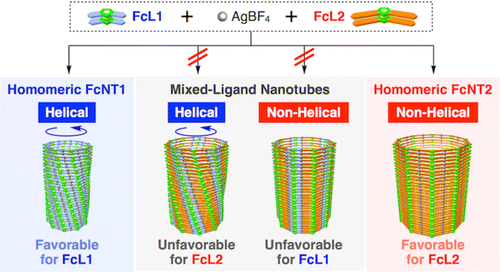当前位置:
X-MOL 学术
›
J. Am. Chem. Soc.
›
论文详情
Our official English website, www.x-mol.net, welcomes your
feedback! (Note: you will need to create a separate account there.)
Self-Sorting in the Formation of Metal–Organic Nanotubes: A Crucial Role of 2D Cooperative Interactions
Journal of the American Chemical Society ( IF 14.4 ) Pub Date : 2016-07-14 , DOI: 10.1021/jacs.6b04693
Maiko Obana 1 , Takahiro Fukino 1 , Takaaki Hikima 2 , Takuzo Aida 1, 3
Journal of the American Chemical Society ( IF 14.4 ) Pub Date : 2016-07-14 , DOI: 10.1021/jacs.6b04693
Maiko Obana 1 , Takahiro Fukino 1 , Takaaki Hikima 2 , Takuzo Aida 1, 3
Affiliation

|
A mixture of ferrocene-based tetratopic pyridyl ligands FcL1 and FcL2 undergoes self-sorting upon competitive coordination with AgBF4, affording homomeric nanotubes FcNT1 and FcNT2 as a mixture. No mutual interference for the nanotubular growth occurred between FcNT1 and FcNT2 even when one of these ligands was used in large excess with respect to the other. 2D X-ray diffraction analysis of unidirectionally oriented nanotube samples, prepared by using the capillary technique, revealed that although FcL1 as reported previously stacks helically in the resulting nanotube FcNT1 FcL2 prefers to stack with no discernible helical twist in FcNT2. Such a difference in their stacking geometries is most likely a major reason for why mixed-ligand metal-organic nanotubes are not constructed upon competitive coordination of FcL1 and FcL2 with AgBF4.
中文翻译:

金属-有机纳米管形成中的自分类:二维协同相互作用的关键作用
基于二茂铁的四位吡啶基配体 FcL1 和 FcL2 的混合物在与 AgBF4 竞争配位后进行自分选,得到均聚纳米管 FcNT1 和 FcNT2 作为混合物。即使当这些配体中的一个相对于另一个大量过量使用时,FcNT1 和 FcNT2 之间也不会发生对纳米管生长的相互干扰。通过使用毛细管技术制备的单向定向纳米管样品的 2D X 射线衍射分析表明,尽管先前报道的 FcL1 在所得纳米管 FcNT1 中呈螺旋状堆叠,但 FcL2 更倾向于在 FcNT2 中没有可辨别的螺旋扭曲的情况下堆叠。它们堆叠几何形状的这种差异很可能是为什么混合配体金属有机纳米管不是基于 FcL1 和 FcL2 与 AgBF4 的竞争配位构建的主要原因。
更新日期:2016-07-14
中文翻译:

金属-有机纳米管形成中的自分类:二维协同相互作用的关键作用
基于二茂铁的四位吡啶基配体 FcL1 和 FcL2 的混合物在与 AgBF4 竞争配位后进行自分选,得到均聚纳米管 FcNT1 和 FcNT2 作为混合物。即使当这些配体中的一个相对于另一个大量过量使用时,FcNT1 和 FcNT2 之间也不会发生对纳米管生长的相互干扰。通过使用毛细管技术制备的单向定向纳米管样品的 2D X 射线衍射分析表明,尽管先前报道的 FcL1 在所得纳米管 FcNT1 中呈螺旋状堆叠,但 FcL2 更倾向于在 FcNT2 中没有可辨别的螺旋扭曲的情况下堆叠。它们堆叠几何形状的这种差异很可能是为什么混合配体金属有机纳米管不是基于 FcL1 和 FcL2 与 AgBF4 的竞争配位构建的主要原因。







































 京公网安备 11010802027423号
京公网安备 11010802027423号